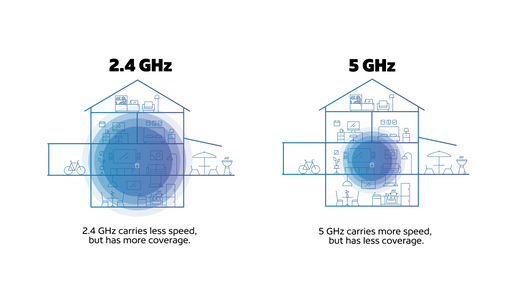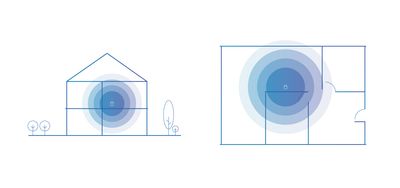- Shaw Support
- :
- Articles
- :
- Internet Articles
- :
- Troubleshooting: WiFi connection issues
- Article History
- Bookmark
- Subscribe
- Printer Friendly Page
- Report Inappropriate Content
Troubleshooting: WiFi connection issues
In most conditions, your home WiFi connection with Shaw Internet should be stable and fast. Disconnections and slow speeds can be a result of weak signals, device capabilities, or interference. If you suspect that your WiFi isn't working as it should, try our WiFi troubleshooting solutions below to improve your Internet connectivity.
You may also want to consider upgrading the tier of your Internet package to get faster Internet speed.
Your Internet plan and device usage
Your Internet connection and WiFi speed can be impacted by the tier of your Internet plan and by device usage in your home. The maximum speed (bandwidth) on your Internet plan will be shared by all the devices connected to your home WiFi network.
It is normal to experience slower speeds if you have many devices connected at once, or one device consistently uploading/downloading substantial amounts of data. (This is more noticeable on slower-speed packages).
To determine your overall Internet usage, check to see:
- How many devices are connected to your home WiFi network at peak times?
- If your devices are running bandwidth-heavy programs (e.g. streaming, downloading)
- If video games are being played online as this can also impact online connection activity
If you noticed that you have a large number of connected devices and feel it might be impacting connectivity, try closing apps and reducing the number of connected devices, to see if performance improves for the devices still connected.
To see a list of our different Internet plans visit: Shaw Internet plans
To learn more about Internet speed tests visit our FAQ on: Shaw Speed Test
Signal Strength - 2.4 GHz vs 5 GHz WiFi frequencies
When selecting your WiFi network on a device, you might have a choice between 5 GHz and 2.4 GHz frequencies which should be decided based on the location, distance, and requirements of your devices.
Note: Rogers Xfinity Gateway (formerly known as Fibre+ Gateway) supports both 2.4 GHz and 5 GHz bands, but these won't appear separately in lists of available networks. Instead, the modem automatically routes your devices to the optimal frequency using a feature called band steering.
5 GHz frequency can carry more data and supply faster speed, but it has less coverage and is affected more easily by common obstacles.
- Convenient for devices relying on higher data and speed, such as streaming devices and smart TVs
2.4 GHz frequency has a better range but lower speed which tends to be affected by any radio interference easily compared to 5 GHz frequency.
- More suitable for devices that don’t rely on fast speeds, such as non-streaming smart devices like thermostats, voice assistants, light bulbs, and security cameras.
If you have an Rogers Xfinity Gateway with the band steering feature enabled, your modem will sort devices to the fastest frequency automatically, and you will only see one frequency to connect to.
Note: If one of your devices doesn't see a 5 GHz option while the others can, consider plugging it directly into your modem to ensure high speed.
Restart the modem
Many WiFi issues can be corrected by simply restarting your modem. The quickest way to do this is online using My Shaw. Visit How To: Restart your modem with My Shaw to learn more.
If you have the Rogers Xfinity Gateway, we recommend you restart it using the Rogers Xfinity App (formerly known as Ignite HomeConnect App) or My Shaw App. Learn how by visiting Troubleshooting: Fix home WiFi network issues with Rogers Xfinity.
Alternatively, you can restart your Shaw modem by removing and reconnecting the power:
- Unplug the power cable from the back of the WiFi Modem.
- Wait 30 seconds.
- Reconnect the power cable to the modem.
- When your WiFi network appears in the list of available networks on your device, try connecting to it to see if it works.
Although Shaw does not support third-party routers, if you have a wireless router (common brands include: D-Link, Netgear, Linksys and Belkin) connected to your Shaw Internet modem, read Power cycle your equipment.
Modem Location & WiFi Range
For better WiFi coverage, the modem should be in a central location in your home, or central to where you most often use the Internet. To learn more, watch our video on the importance of modem placement. Or you can visit About: Modem Placement & Range article.
If it is already in a central location and you're still getting dead spots, you may consider extending your Wi-Fi network into every corner of your home using extenders like the Rogers Xfinity WiFi Boost Pods (Gen 2) (formerly known as Fibre+ WiFi Pods) from Shaw. Pods won't increase speeds, but they will increase Wi-Fi range, for more details read the article Rogers Xfinity WiFi Boost Pods FAQ.
WiFi Obstacles & interference
To work well, your Shaw modem should be positioned where there is the least physical interference. Use these tips to reduce WiFi interference:
- Confirm that the modem isn’t near, or behind other electronics like cordless phones, microwave ovens, garage door openers, TVs, and other wireless electronics.
- Ensure that the modem has a line of sight to your devices whenever possible, and isn’t blocked from view by cupboards or cabinets.
- Major appliances like fridges & ovens, and metal furnishings such as mirrors and filing cabinets will have a significant impact.
- Your neighbors also have wireless electronic devices which may affect your WiFi quality if your dwellings are close enough.
- Peak Wireless Traffic Hours are when radio frequencies are congested by a high number of users during the same time. For example, when everyone is arriving home from work or school, and more devices are now active in the home environment.
- Older devices tend to be affected by interference more easily.
- Building materials will impact your signal in diverse ways. For example, ceramic floor tiles will absorb more WiFi signal than panel and vinyl.
For more information and remedies, read the article About: WiFi interference.
How to restore your modem's settings
Although rare, the software on the modem could cause connectivity issues. As one of the last WiFi troubleshooting tips we recommend, it might help to restore your modem to its factory settings. However, this will also reset your default password and network name to those found on the sticker on the back of your modem.
If you have an Rogers Xfinity Gateway, performing a pin-hole reset will stop internet access and remove all customized settings, including WiFi channel and network name until you follow the steps in the article Connect your Rogers Xfinity Gateway
Factory reset Rogers Xfinity Gateway (XB6)
- Locate the small pin-hole reset button on the back of the Rogers Xfinity Gateway.
- Push and hold this button down for 30 seconds with a paperclip or pen. This will cause the modem lights to begin to flash. After a few moments, the modem will come back online.
- When your WiFi network appears in the list of available networks on your device, try connecting to it to see if it works.
Factory reset Rogers Xfinity Gateway Gen 2 and 3 (XB7, XB8)
- Locate the WPS button located on the back of the Rogers Xfinity Gateway.
- Push and hold this button down for 30 seconds. This will cause the modem lights to begin to flash. After a few moments, the modem will come back online.
- When your WiFi network appears in the list of available networks on your device, try connecting to it to see if it works.
Remember: resetting your modem to factory defaults will reset your default password and network name to those found on the sticker on the back of your modem.
Related readings
Not what you're looking for? Try these related articles and discussions.



